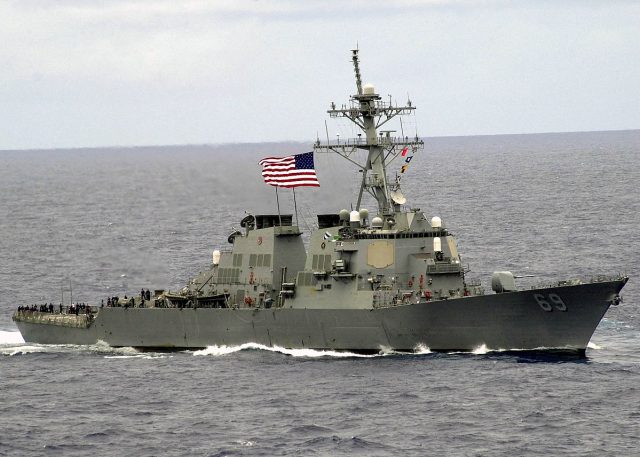
The United States Navy’s guided-missile destroyer, USS Milius, has conducted a freedom of navigation operation within 12 nautical miles of Panganiban Reef, a Chinese military base located within the Philippines’ exclusive economic zone (EEZ). This move has been described by China as an “illegal” intrusion.
The Chinese air force reportedly carried out surveillance of the vessel during the operation, and the spokesperson for the Chinese military’s Southern Theater Command has issued a statement condemning the US Navy’s operation.
Panganiban Reef is one of China’s largest artificially built islands in the Spratly Chain, also known in the Philippines as the Kalayaan island group. It boasts a 3-km airstrip, missile shelters, hangars, and radars.
The Philippines has nine small military detachments in these waters, which it calls the West Philippine Sea, while other claimants aside from China are maintaining their own outposts.
China claims the entire South China Sea, including the West Philippine Sea, waters within the country’s EEZ, while the Philippines, China, Brunei, Vietnam, Taiwan, and Malaysia have overlapping claims in the area. In a landmark 2016 ruling, the Permanent Court of Arbitration in The Hague rejected China’s massive “nine-dash-line” claims in the sea.
The USS Milius mission took place as China was expected to conclude the third day of its military exercises around Taiwan, and as the Philippines and the United States were set to begin their largest-ever military exercises.
The war games follow a meeting last week between Taiwanese President Tsai Ing-wen and US House Speaker Kevin McCarthy outside Los Angeles. China’s exercises sparked condemnation from Taipei and a call for restraint from Washington, which said it was “monitoring Beijing’s actions closely.”
The destroyer had “asserted navigational rights and freedoms in the South China Sea near the Spratly Islands, consistent with international law.” The 7th Fleet said that the land reclamation efforts, installations, and structures built on Mischief Reef do not change this characterization under international law.
China’s People’s Liberation Army said that the US warship had “illegally” entered waters near the reef without Chinese approval. China also said that the vessel was monitored by the forces and a warning was also issued.
On Monday, April 10, Beijing said fighter jets carrying “live ammunition” had conducted “simulated strikes” near Taiwan, and that its Shandong aircraft carrier was involved in the ongoing exercises.
The 7th Fleet said, “unlawful and sweeping maritime claims in the South China Sea pose a serious threat to the freedom of the seas, including the freedoms of navigation and overflight, free trade and unimpeded commerce, and freedom of economic opportunity for South China Sea littoral nations.”
The international tribunal also ruled that Panganiban Reef is a low-tide feature that constitutes part of the EEZ and continental shelf of the Philippines, over which it exercises sovereign rights. However, China does not recognize the arbitral ruling.
Beginning Tuesday, the United States and the Philippines will stage the 18-day Balikatan military exercises, involving more than 17,000 troops. Meanwhile, Chinese fighter jets and warships are carrying out three days of military drills around Taiwan, including simulated strikes on the island.
The ongoing conflict in the South China Sea is a matter of global concern, with several nations laying claim to the region. The international community should ensure that the region’s territorial claims are resolved in a peaceful and lawful manner, adhering to international law and the United Nations Convention on the Law of the Sea.





